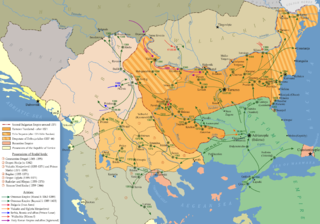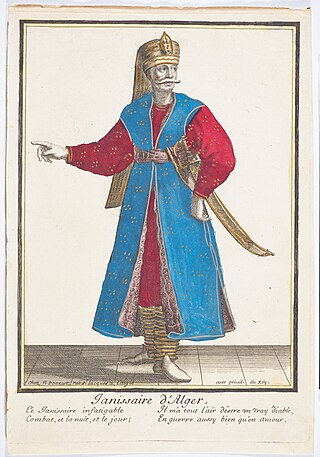
A Janissary was a member of the elite infantry units that formed the Ottoman Sultan's household troops and the first modern standing army in Europe. The corps was most likely established under sultan Orhan (1324–1362), during the Viziership of Alaeddin.
Ottoman military reforms began in the late 18th century.

Sipahi were professional cavalrymen deployed by the Seljuks, and later the Ottoman Empire, including the land grant-holding (timar) provincial timarli sipahi, which constituted most of the army, and the salaried regular kapikulu sipahi, or palace troops. However, the irregular light cavalry akıncı ("raiders") were not considered to be sipahi. The sipahi formed their own distinctive social classes and were rivals to the Janissaries, the elite infantry corps of the Sultan.

Selim III was the sultan of the Ottoman Empire from 1789 to 1807. Regarded as an enlightened ruler, the Janissaries eventually deposed and imprisoned him, and placed his cousin Mustafa on the throne as Mustafa IV. Selim was subsequently killed by a group of assassins.

Devshirme was the Ottoman practice of forcibly recruiting soldiers and bureaucrats from among the children of their Balkan Christian subjects. Those coming from the Balkans came primarily from noble Balkan families and rayah classes. It is first mentioned in written records in 1438, but probably started earlier. It created a faction of soldiers and officials loyal to the Sultan. It counterbalanced the Turkish nobility, who sometimes opposed the Sultan. The system produced a considerable number of grand viziers from the 1400s to the 1600s. This was the second most powerful position in the Ottoman Empire, after the sultan. Initially, the grand viziers were exclusively of Turk origin, but after there were troubles between Sultan Mehmed II and the Turkish grand vizier Çandarlı Halil Pasha the Younger, who was the first grand vizier to be executed, there was a rise of slave administrators (devshirme). They were much easier for the sultans to control, compared to free administrators of Turkish aristocratic extraction. The devshirme also produced many Ottoman Empire's provincial governors, military commanders, and divans during the 1400s–1600s period. Sometimes, the devshirme recruits were castrated and became eunuchs. Although often destined to the harem, many eunuchs of devshirme origin went on to hold important positions in the military and the government, such as grand viziers Hadım Ali Pasha, Sinan Borovinić, and Hadım Hasan Pasha.

The military of the Ottoman Empire was the armed forces of the Ottoman Empire.

The Auspicious Incident was the forced disbandment of the centuries-old Janissary corps by Sultan Mahmud II on 15 June 1826. Most of the 135,000 Janissaries revolted against Mahmud II, and after the rebellion was suppressed, most of them were executed, exiled or imprisoned. The disbanded Janissary corps was replaced with a more modern military force.

Alemdar Mustafa Pasha was an Ottoman military commander and a Grand Vizier born in Hotin in the then Ottoman territory of Ukraine in 1765. Of Albanian origin, he hailed from the village of Goskovë near Korçë).

The Nizam-i Cedid was a series of reforms carried out by Ottoman Sultan Selim III during the late 18th and the early 19th centuries in a drive to catch up militarily and politically with the Western powers. The New Order regime was launched by Selim III and a coalition of reformers. Its central objectives were the creation of a professional army along European lines, a private treasury to finance military spending and other administrative reforms. The age of the New Order can be generally said to have lasted from 1789 to 1807, when Selim III was deposed by a Janissary coup.

The Regency of Algiers was a state in North Africa lasting from 1516 to 1830, until it was conquered by the French. Situated between the regency of Tunis in the east, the Sultanate of Morocco in the west and Tuat as well as the country south of In Salah in the south, the Regency originally extended its borders from La Calle in the east to Trara in the west and from Algiers to Biskra, and afterwards spread to the present eastern and western borders of Algeria.

The history of Ottoman Bulgaria spans nearly 500 years, from the conquest by the Ottoman Empire of the smaller kingdoms emerging from the disintegrating Second Bulgarian Empire in the late 14th century, to the Liberation of Bulgaria in 1878. As a result of the Russo-Turkish War (1877–1878), the Principality of Bulgaria, a self-governing Ottoman vassal state that was functionally independent, was created. In 1885 the Ottoman autonomous province of Eastern Rumelia came under the control of and was unified with the Principality of Bulgaria. Bulgaria declared independence in 1908.
The Orta is the main military division of the janissary odjak, which initially under the reign of Sultan Murad I numbered 1,000 new soldiers divided into 10 Ortas.
Çandarlı Kara Halil Hayreddin Pasha was the first Grand Vizier of Murad I's reign. He was also technically the first in Ottoman history who held the title "Grand Vizier", the first who had a military background, and the first member of the illustrious Çandarlı family to hold high office. His family was to mark the rise of the Ottoman Empire between 1360 and 1450.

The Mansure Army was an ocak of the Ottoman army. It was established by Mahmud II, who also disbanded the Janissary Corps.
Yaya or Piyade were infantry military units of the Ottoman Empire and some other medieval Anatolian beyliks. Many of them were of Christian origin.

The Agha of the Janissaries or Janissary Agha was a top Ottoman military official and courtier, and the commander of the Janissary corps. Apart from the commander-general of the entire corps, the title of "Agha of the Janissaries" was also borne by the commander of a provincial garrison of Janissaries.
The Ottoman army was the military structure established by Mehmed II, during his reorganization of the state and the military. This was the major reorganization following Orhan's standing army of janissaries that were paid by salary rather than booty or fiefs. This army was the force during the rise of the Ottoman Empire. The organization was twofold, central (Kapıkulu) and peripheral (Eyalet). This army was forced to disband by Sultan Mahmud II on 15 June 1826 in what is known as Auspicious Incident, which followed a century-long reform effort.

The Nizam-ı Cedid Army refers to the new military establishment of the Nizam-ı Cedid reform program. The Nizam-i Cedid army was largely a failure in its own time, but proved to be a much more effective infantry force than the Janissaries.

The Janissary Corps is a kind of military formation of the Ottoman Empire of the Late Middle Ages, which lived to the Modern age. The janissary corps is a central pillar, hence its name "corpus" of the Army of the classical Ottoman Empire and, in particular, of the Ottoman power in the person of the Sultan, since 1517 — Caliph of the orthodox.

The Odjak of Algiers was a unit of the Algerine army. It was a heavily autonomous part of the Janissary Corps, acting completely independently from the rest of the corps, similar to the relationship between Algiers and the Sublime Porte. Led by an Agha, they also took part in the country's internal administration, and politics, ruling the country for several years. They acted as a defense unit, a Praetorian Guard, and an instrument of repression until 1817.













